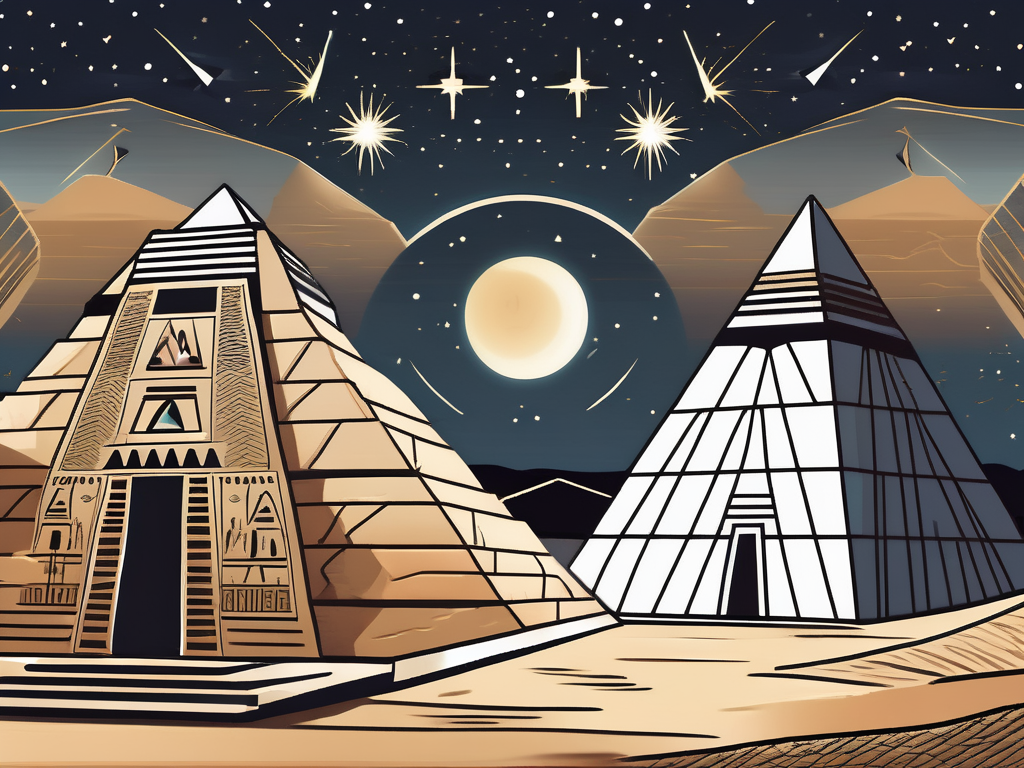Are you intrigued by the captivating mythology of ancient Egypt? If so, you have undoubtedly come across the name Apep. This enigmatic deity, also known as Apophis, stands out as one of the most fearsome and intriguing figures in Egyptian mythology. Join us as we embark on a journey to unravel the mysteries surrounding this ancient god and explore the many facets of Apep’s intriguing mythology.
Understanding the Mythology of Apep
Before we delve into the depths of Apep’s lore, it is crucial to gain a comprehensive understanding of the mythology surrounding this divine entity. Apep’s story originates in the ancient Egyptian culture, where beliefs and tales shaped the lives of the people. Let us explore the fascinating origin of Apep in ancient Egyptian culture and the role this deity played in the mythology.
The Origin of Apep in Ancient Egyptian Culture
Apep’s story begins in the ancient Egyptian cosmology, where the forces of order and chaos held a delicate balance. It is believed that Apep emerged from the primordial waters of Nun, symbolizing chaos and destruction. As an embodiment of chaos, Apep posed a constant threat to the harmony maintained by the Egyptian pantheon.
According to the ancient Egyptians, Apep was a massive serpent, often depicted as a fearsome creature with a body stretching across the horizon. It was said that Apep’s scales were as black as the night sky, and its eyes glowed with a fiery red hue. The mere presence of Apep was enough to instill fear and unease in the hearts of the ancient Egyptians.
Legend has it that Apep’s venomous breath could corrupt the very essence of life, turning fertile lands into barren wastelands and causing sickness and suffering among the people. The ancient Egyptians believed that Apep’s malevolence extended beyond the physical realm, as it sought to disrupt the cosmic balance and plunge the world into eternal darkness.
Apep’s Role in Egyptian Mythology
In the vast tapestry of Egyptian mythology, Apep assumed a significant role. This malevolent serpent embodied the forces of chaos and evil, forever seeking to devour the sun god, Ra, and plunge the world into eternal darkness. To counter this nefarious threat, the Egyptian deities stood united, engaging in an eternal battle against Apep to preserve order and ensure the cycle of life.
The battle between Apep and Ra was not merely a physical confrontation but a cosmic struggle between the forces of light and darkness. Each day, as Ra embarked on his journey across the sky, Apep would lie in wait, attempting to swallow the sun and bring about everlasting night. The Egyptian deities, led by the powerful god Set, would fiercely combat Apep, using their divine powers to repel the serpent’s advances and protect Ra.
This eternal battle between Apep and the Egyptian deities became a symbol of the ongoing struggle between chaos and order, good and evil. The ancient Egyptians believed that by participating in rituals and offering prayers, they could aid the gods in their fight against Apep, ensuring the continued existence of the world and the prosperity of their civilization.
Apep’s role in Egyptian mythology extended beyond its physical manifestation. The serpent also represented the internal struggles faced by individuals, symbolizing the temptations and obstacles that could lead one astray from the path of righteousness. It served as a reminder of the constant need to resist chaos and embrace order in one’s own life.
Apep’s Symbolism and Representation
As we delve deeper into the enigmatic realm of Apep, it becomes evident that symbolism pervades this deity’s mythology. The serpent imagery associated with Apep plays a pivotal role in understanding its significance. Additionally, Apep’s association with chaos and evil unveils another layer of symbolism within Egyptian mythology.
The Serpent Imagery of Apep
Throughout ancient Egyptian art and literature, Apep is often depicted as a gigantic serpent, its scaly body coiled menacingly. The snake serves as a powerful symbol of primal chaos and the timeless struggle between light and darkness. The striking imagery of Apep in serpent form captivated the imaginations of the ancient Egyptians, illustrating the power and danger it represented.
One can imagine the awe and fear that must have accompanied the sight of Apep, with its massive form slithering through the depths of the underworld. The serpent’s sinuous movements and piercing gaze would have struck terror into the hearts of those who encountered it. Its presence alone was a reminder of the ever-present threat of chaos, lurking just beneath the surface of the ordered world.
Furthermore, the serpent’s association with Apep also draws parallels to the cyclical nature of life and death. In ancient Egyptian cosmology, the snake shedding its skin symbolized renewal and rebirth. This connection suggests that Apep’s destructive power was not merely a force of annihilation, but also a necessary catalyst for transformation and renewal.
Apep’s Association with Chaos and Evil
Within the pantheon of Egyptian deities, Apep embodies the embodiment of chaos and evil. It represents the very antithesis of all that is order and goodness. By personifying chaos, Apep emphasizes the vital role played by harmony and stability in the ancient Egyptian worldview. The constant threat posed by Apep reinforces the need for vigilance in preserving order in both the physical and spiritual realms.
Apep’s association with evil goes beyond its role as a chaotic force. In Egyptian mythology, evil was not simply a concept, but a tangible and malevolent entity. Apep personified this malevolence, serving as a reminder of the potential darkness that exists within the human psyche. Its presence in the mythology of ancient Egypt served as a cautionary tale, warning against the temptations of chaos and the destructive power of unchecked evil.
Moreover, Apep’s association with chaos and evil also highlights the importance of Ma’at, the ancient Egyptian concept of cosmic order and balance. The constant battle between Apep and the sun god Ra symbolized the eternal struggle between chaos and order, darkness and light. It was through this conflict that the Egyptians sought to maintain the delicate equilibrium of the universe, ensuring the continued existence of their civilization.
In conclusion, Apep’s symbolism and representation in ancient Egyptian mythology are rich and multifaceted. The serpent imagery evokes both fear and fascination, while its association with chaos and evil serves as a reminder of the fragility of order and the constant need for vigilance. Apep’s role in the cosmic battle between light and darkness underscores the ancient Egyptians’ belief in the importance of maintaining harmony and balance in all aspects of life.
Apep’s Adversaries: The Egyptian Gods
In the enthralling tales of Egyptian mythology, the gods stood as the defenders of order against the relentless onslaught of Apep. These deities engaged in fierce battles to thwart the serpent’s malevolent plans and preserve the balance that sustained creation. Let’s explore the tumultuous relationship between Apep and the Egyptian gods.
Apep and Ra: The Eternal Battle
One of the central conflicts in Egyptian mythology revolves around the enduring struggle between Apep and Ra, the sun god. Every night, as Ra embarked on his perilous journey through the underworld, Apep lay in wait, hoping to devour him and plunge the world into darkness. The relentless battle between these two formidable beings epitomized the eternal struggle between good and evil.
Other Deities’ Relationship with Apep
While Ra bore the brunt of Apep’s wrath, many other Egyptian deities also played essential roles in combating the primordial chaos. Gods such as Set, the patron of chaos, and Bastet, the goddess of protection, stood alongside Ra, defending the forces of good against Apep’s unyielding assault. Their collective efforts highlighted the unity and cooperation prevalent among the Egyptian pantheon in times of great peril.
Rituals and Practices Associated with Apep
As we explore the deep-rooted mythology surrounding Apep, it is essential to understand the rituals and practices associated with this deity. Ancient Egyptians employed various ancient rituals to ward off the malevolent influence of Apep and safeguard their world from chaos.
The Rituals for Warding Off Apep
Facing the relentless threat of Apep, the ancient Egyptians devised elaborate rituals to protect themselves from the serpent’s malevolence. These rituals involved invoking the protection of specific deities, reciting sacred incantations, and performing symbolic magical acts. Through these collective efforts, the ancient Egyptians sought to maintain the balance necessary for a prosperous and harmonious existence.
Apep’s Influence on Daily Life in Ancient Egypt
Apep’s pervasive presence in Egyptian mythology also extended its influence into the daily lives of the ancient Egyptians. The constant vigilance required to fend off chaos echoes in the rituals and practices undertaken by the people. The fear and respect instilled by Apep’s mythology ensured that order and harmony permeated all aspects of ancient Egyptian society.
Apep’s Legacy in Modern Culture
The allure of ancient Egyptian mythology spans across time, captivating modern minds and inspiring various forms of artistic expression. Apep, with its fascinating mythology, has left a lasting legacy that resonates in current literature, popular culture, and modern interpretations of ancient tales.
Apep in Literature and Popular Culture
Apep’s presence can be felt in numerous literary works and popular culture representations. Famed authors and contemporary creators have drawn upon the primal power of Apep to infuse their stories with an element of conflict and fascination. If you keep an eye out, you will undoubtedly encounter Apep’s serpentine shadow lurking within the pages of many tales.
Modern Interpretations of Apep’s Mythology
In the ever-evolving realm of mythology, ancient tales often find new life through modern interpretations. Apep’s mythology continues to be analyzed and reimagined, allowing for a deeper understanding of the underlying themes and cultural significance. These contemporary interpretations ensure that Apep’s enigmatic presence remains relevant, continuing to captivate and intrigue audiences worldwide.
In Conclusion
Apep, the ancient Egyptian deity synonymous with chaos and malevolence, has left an indelible mark on the pages of mythology. Through its captivating symbolism and enduring tales of battles against the forces of good, Apep continues to fascinate both scholars and enthusiasts alike. As we unveil the mysteries surrounding this enigmatic god, we must strive to appreciate the profound significance of Apep’s mythology in shaping the ancient Egyptian worldview and its contemporary legacy in our world today.












